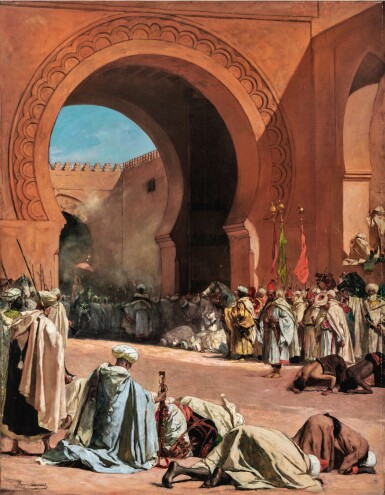
JEAN-JOSEPH BENJAMIN-CONSTANT | THE KING OF MOROCCO LEAVING TO RECEIVE A EUROPEAN AMBASSADOR
Auction Closed
October 22, 05:34 PM GMT
Estimate
400,000 - 600,000 GBP
Lot Details
Description
JEAN-JOSEPH BENJAMIN-CONSTANT
French
1845-1902
THE KING OF MOROCCO LEAVING TO RECEIVE A EUROPEAN AMBASSADOR
signed Benj. Constant lower left
oil on canvas
136 by 106cm., 53½ by 41½in.
Auguste Dreyfus de Gonzalès, Paris (until 1896)
Mathaf Gallery, London (by 1984)
Purchased from the above
Paris, Cercle de l'Union artistique, 1885
Paris, Galerie Georges Petit, 1896, no. 11
London, The Mathaf Gallery, Spring Exhibition of Important Orientalist Paintings of the 19th Century, 1984, no. 23, illustrated in the catalogue
Sydney, The Art Gallery of New South Wales; Auckland, Auckland Art Gallery, Orientalism: Delacroix to Klee, 1997-98, no. 65, illustrated in the catalogue
Brussels, Musées des Beaux-Arts de Belgique; Munich, Kunsthalle der Hypo-Kulturstiftung; Marseilles, Centre de la Vieille-Charité; De Delacroix à Kandinsky. L'Orientalisme en Europe, 2011, no. 6
Toulouse, Musée des Augustins; Montreal, The Montreal Museum of Fine Arts, Benjamin-Constant: Marvels and Mirages of Orientalism, 2014-15, no. 249, illustrated in the catalogue
G. Dargenty, 'Exposition du Cercle de l'Union artistique', in Le Courrier de l'art, 13 February 1885, p. 80
Docteur H. Mireur, Dictionnaire des ventes d'art faites en France et à l'étranger pendant les XVIIIe et XIXe siècles, vol. II, Paris, 1911, p. 239 (listed as L'empereur du Maroc)
Régine Cardis, 'Benjamin-Constant et la peinture orientaliste', in Histoire de l'art, December 1985, pp. 80, 82, 83, 174
Caroline Juler, Najd Collection of Orientalist Paintings, London, 1991, p. 29, discussed; p. 31, catalogued & illustrated
'He is mounted on a superb white horse with a green saddle and trappings, green being the colour of the Emir. The instant the master appears the whole court bows to the ground and, like a murmur at once humble and martial, a clamour ever growing in strength, the cry rises, “May Allah protect our master!”'
The artist, describing the meeting of Sultan Sidi Mohammed with the French diplomat Charles-Joseph Tissot
Framed by the Moorish horseshoe arch of the fortified gate, the present work immerses the viewer in a scene of high pageantry and ceremony bathed in luminous Moroccan light. The Sultan, distant and mounted on a white horse and shielded by a parasol, emerges as his subjects bow to the ground, flags fly, guns are fired and smoke hangs in the air. The scene is thought to derive its immediacy and power from Benjamin-Constant’s first-hand experience some years earlier in 1872, when he accompanied Charles Tissot, the plenipotentiary French minister, on a diplomatic mission from Tangier to Marrakech. Bridgman recounted the scene in Harper’s Bazaar in 1889 (op. cit.). At the same time, the artist was clearly thinking of Eugène Delacroix’ celebrated earlier composition of the Sultan leaving a walled city: Moulay Abd ar-Rahman, Sultan of Morocco, Leaving the Palace in Meknès (fig. 1). In turn, the composition also recalls Benjamin-Constant’s composition of some five years earlier, The Last Rebels, Scene of Moroccan History (fig. 2). Both works reveal the shift in the artist’s style from harem and desert scenes to grand and powerful compositions that project a cinematic gravitas of great history paintings.
